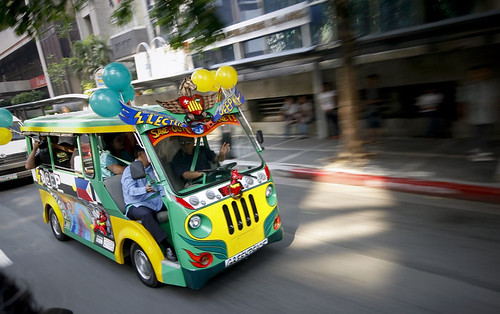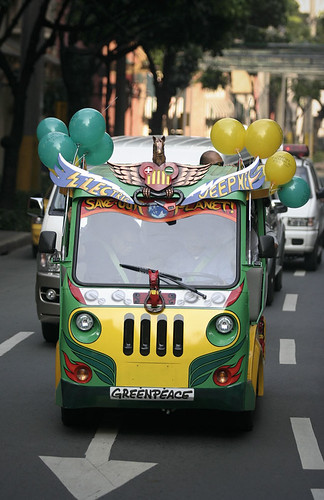Simulan natin ang Bagong Taon (2010) ng bagong buhay at mas mapaghalaga sa kalikasan. Narinig nyo na ba ang E-jeepney? Kung hindi pa ay kaylangan nyo ito malaman at suportahan. Kung bakit ay ating tuklasin.
 Ang E-jeepney o Electrical Jeepneyay ang mapanlikhang isip ng Green Renewable Independent Power Producers, Inc. o GRIPP sa pakikipagtulungan kay Mr Robert Puckett, Pangulo ng Solar Electric Company sa Pilipinas. Ang mga E-jeepneys o minibuses, sa ilalim ng suporta ng Greenpeace, nagsimula tumakbo sa kalye ng Manila / Makati City noong Hulyo 1, 2008.4 na e-jeeps ay inilunsad sa pamamagitan ng Makati mayor Jejomar Binay noong 2007, may 2 modelo mula sa Guangzhou, China na P 371,280 sa bawat isa. ""The first public transport system of its kind in South-East Asia," ang mga sasakyan na maaaring i-charge sa pamamagitan ng plugging sa isang electric socket, gamit ang kapangyarihan mula sa biodegradable na basura. Gusto ring simulan agad ang komersyal na operasyon ng sa Puerto Princesa, Bacolod at Cebu. Ang 2 bagong e-jeeps ay ginawa ng Motor Vehicle Parts Manufacturers Association of the Philippines (MVPMAP) habang ang unang 4 na yunit ay ginawa sa Tsina. Ang Land Transportation Franchising atand Regulatory Board ay inuri at nakarehistro ito bilang LSV (low-speed vehicles) o 4-wheeled motor vehicles na gumagamit ng alternatibong fuel tulad ng kuryente at pagpapatakbo ng isang maximum na 40 km bawat oras. Ang E-jeepney naglalaman ng 17 pasahero at maaaring magpatakbo ng 120 km sa isang 8-oras na pagka-charge mula sa isang electric outlet. Ito ay ayon sa Wikipedia.
Ang E-jeepney o Electrical Jeepneyay ang mapanlikhang isip ng Green Renewable Independent Power Producers, Inc. o GRIPP sa pakikipagtulungan kay Mr Robert Puckett, Pangulo ng Solar Electric Company sa Pilipinas. Ang mga E-jeepneys o minibuses, sa ilalim ng suporta ng Greenpeace, nagsimula tumakbo sa kalye ng Manila / Makati City noong Hulyo 1, 2008.4 na e-jeeps ay inilunsad sa pamamagitan ng Makati mayor Jejomar Binay noong 2007, may 2 modelo mula sa Guangzhou, China na P 371,280 sa bawat isa. ""The first public transport system of its kind in South-East Asia," ang mga sasakyan na maaaring i-charge sa pamamagitan ng plugging sa isang electric socket, gamit ang kapangyarihan mula sa biodegradable na basura. Gusto ring simulan agad ang komersyal na operasyon ng sa Puerto Princesa, Bacolod at Cebu. Ang 2 bagong e-jeeps ay ginawa ng Motor Vehicle Parts Manufacturers Association of the Philippines (MVPMAP) habang ang unang 4 na yunit ay ginawa sa Tsina. Ang Land Transportation Franchising atand Regulatory Board ay inuri at nakarehistro ito bilang LSV (low-speed vehicles) o 4-wheeled motor vehicles na gumagamit ng alternatibong fuel tulad ng kuryente at pagpapatakbo ng isang maximum na 40 km bawat oras. Ang E-jeepney naglalaman ng 17 pasahero at maaaring magpatakbo ng 120 km sa isang 8-oras na pagka-charge mula sa isang electric outlet. Ito ay ayon sa Wikipedia. (from wikipedia.com)
(from wikipedia.com)E-jeepneys, short for electrical Jeepneys, were the brainchild of Green Renewable Independent Power Producers, Inc. or GRIPP in partnership with Mr Robert Puckett, President of Solar Electric Company in the Philippines. These E-jeepneys or minibuses, under the support of Greenpeace started plying Manila / Makati City streets on July 1, 2008. 4 e-jeeps were launched by Makati mayor Jejomar Binay on 2007, with 2 prototypes from Guangzhou, China at P 371,280 each. "The first public transport system of its kind in South-East Asia," the vehicles can be charged by plugging into an electric socket, using power from biodegradable waste.[4] E-jeepneys would also soon begin commercial operations in Puerto Princesa, Bacolod and Baguio. The 2 new e-jeeps were made by the Motor Vehicle Parts Manufacturers Association of the Philippines (MVPMAP), while the first 4 units were made in China. The Land Transportation Franchising and Regulatory Board classified and registered them as LSV (low-speed vehicles) or 4-wheeled motor vehicles that use alternative fuel such as electricity and running a maximum 40 km per hour. The E-jeepney carries 17 passengers and can run 120 km on an 8-hour charge from an electric outlet.
(from wikipedia.com)
I would like to share an article from Inquirer.net about the e-jeepney last 2007.
 (start of the article from inquirer.net)
(start of the article from inquirer.net)E-jeepney electrifies Makati folk
By DJ Yap
Inquirer
First Posted 06:08:00 07/05/2007
Filed Under: Road Transport, Alternative energy, Climate Change
MANILA, Philippines -- On their first excursion in the streets of the metropolis Wednesday, the two brightly painted “e-jeepneys” did not roar at all.
They did not even purr.
For that matter, they did not hiss, or cough, or sputter, like all public utility jeepneys do. Instead, these Earth-friendly cousins of the jeepney wove their way around the Makati central business district quietly -- and with nary a puff of smoke from their glossy behinds.
Costing P500,000 each and running on batteries charged via electrical sockets overnight, the 12-seater e-jeepneys had a test-run along Ayala Avenue as part of a study on the feasibility of using this mode of transport on a metro-wide scale.
And from Wednesday’s demonstration under the hot mid-morning sun, city officials, environmentalists, business executives, and even pedestrians and commuters were of one mind: They liked what they saw.
“Imagine the jeepney as a purely electric machine that belches nothing, makes no noise, has a high headroom, comfortable seating and large windows,” Solar Electric Co. (Solarco) president Panch Puckett said.
“You may even pass the mike around and enjoy sing-alongs while on your way to work,” he added.
Makati Mayor Jejomar Binay, who was among the first to drive the e-jeepney, described the experience as “like riding a golf cart.”
Push button gets it going
“It’s very easy to ride. Because it’s lighter, the jeepney drivers who are so used to the heavy diesel engines will feel a little weird at first, but it only takes a short while to get used to it,” Puckett said.
“You do not hear the engine running. It’s very silent and there’s even a radio for you to check if it’s on,” Joey Salgado, the city’s information and community relations department chief, said.
And how to start the vehicle? “You just push a button,” Salgado said.
As the e-jeepneys traversed the busy section of Ayala Avenue, pedestrians on the sidewalks stopped to watch them whiz past, trailed by photographers and cameramen.
Drivers on the other lane rolled down their windows to watch the convoy, whose route started from the corner of Paseo de Roxas and Ayala Avenue toward the G3 Park in front of the Makati Shangri-La Hotel, and back.
For Binay, the e-jeepneys represent the future of road travel in the financial capital.
Nationwide production
“We hope that we can introduce the electric jeepneys in other cities nationwide,” he said during a brief program after the test run.
“Electric-powered jeepneys are set to revolutionize the Philippines’ most recognizable icon,” Greenpeace campaign director Von Hernandez said.
The e-jeepneys are a venture of Green Renewable Independent Power Producer Inc., which sprang from Greenpeace and other groups, and Solarco, which in turn is a part of GRIPP.
Alternative to pollution
The campaign is part of GRIPP’s Climate Friendly Cities Project, a multi-pronged program for mitigating climate change that promotes transport and waste management initiatives through renewable energy-based technology.
“The e-jeepneys aim to demonstrate that there are climate-friendly alternatives to the current polluting modes of public transportation in the Philippines,” said Athena Ronquillo, GRIPP chair and lead proponent of the e-jeepney initiative.
“The iconic jeepney remains but without wasteful and carbon emitting diesel, and while providing increased incomes to the vehicles’ drivers,” she added.
Celebrities like Amanda Griffin, Juddah Paolo, Richard Gutierrez and Georgina Wilson, who all support Greenpeace, also graced the affair.
“Considering it has no gas tank (just a battery compartment), the e-jeepney runs purely on stored electricity, resulting in a much quieter and fumeless trip,” Puckett said.
“Diesel-powered jeepneys actually waste more fuel while idling. In the case of the e-jeepney, when the driver steps on the break, the engine really stops. It doesn’t idle,” he said.
Long-term prospects
The battery that makes an e-jeepney run has a two-year warranty.
The e-jeepney can run 120 km on a single charge of eight hours, Puckett said.
“If the driver travels at an average speed of 40 kph nonstop, that translates to a three-hour working day. But the stops can extend his hours because the battery is not used up,” Puckett said.
Binay said the city government and its partners had begun talks with major stakeholders, particularly leaders of jeepney drivers’ associations, about the long-term prospects of the project.
“We have no intention of phasing out anybody in this business,” Puckett said.
“This is just to keep people aware and open their minds that there are alternative engines -- we’re not talking about bodies but engines -- in a market that can clean the environment,” he added.
Break from the past
On Wednesday, Binay signed an agreement for the leasing by the city of the two e-jeepneys from GRIPP. If the test run proves feasible, the city will lease more units, officials said.
Binay said they were also looking into the economics of the project.
“If the e-jeepney can help increase the income of jeepney drivers by removing their expenditure for diesel, then all the more reason for us to push ahead with the project,” he said.
For Puckett, the introduction of the e-jeepney means “we have no choice but to improve our lives according to these innovations because everything just keeps getting better and better.”
He said: “The e-jeepney will definitely change the way we think, design, drive, ride, and experience the mode of transportation that has become so much a part of being Filipino.”
(end of inquirer.net article)
Kaylangan nating suportahan ang mga prudukto o bagay na makapagpapabuti sa ating kapaligiran, hindi nakakasira sa ating kalikasan at sa ating kalusugan.
src="http://pagead2.googlesyndication.com/pagead/show_ads.js">
 Photos are from the Flickr Account of the GreenPeace with the description of "Manila, 1 July 2008—An E-Jeepney (Electric Jeepney) coasts down a street in Makati City, in the central business district in the Philippines’ capital city of Manila. GRIPP (Green Renewable Independent Power Producer) and Greenpeace today launched the commercial run the innovative E-Jeepneys, which will now ply a commercial route in public roads. The first public transport of its kind in Southeast Asia, the E-Jeepney intends to steer clear of the use of fossil fuels to help mitigate climate change while while addressing problems such as air pollution, solid waste and rising oil proces. © Greenpeace / Luis Liwanag"
Photos are from the Flickr Account of the GreenPeace with the description of "Manila, 1 July 2008—An E-Jeepney (Electric Jeepney) coasts down a street in Makati City, in the central business district in the Philippines’ capital city of Manila. GRIPP (Green Renewable Independent Power Producer) and Greenpeace today launched the commercial run the innovative E-Jeepneys, which will now ply a commercial route in public roads. The first public transport of its kind in Southeast Asia, the E-Jeepney intends to steer clear of the use of fossil fuels to help mitigate climate change while while addressing problems such as air pollution, solid waste and rising oil proces. © Greenpeace / Luis Liwanag"



